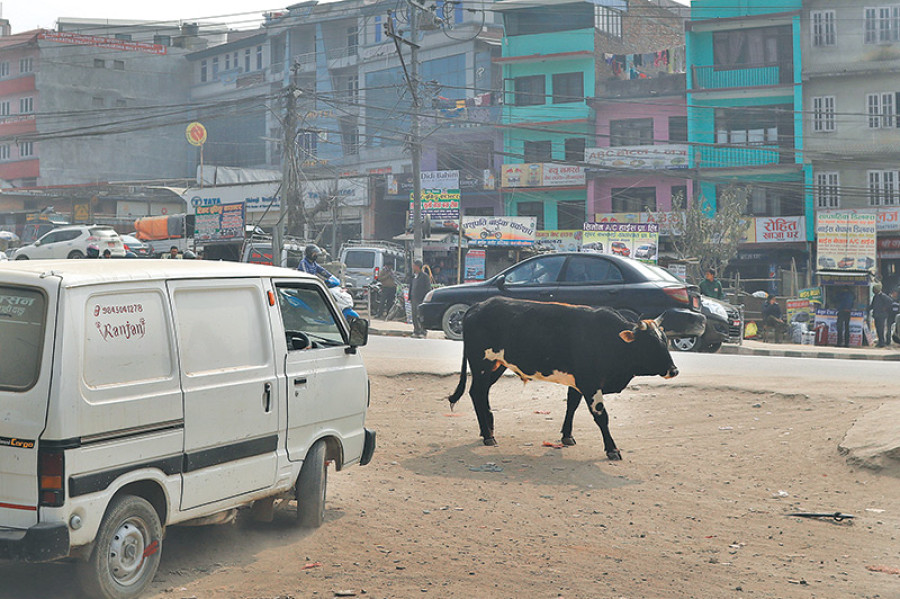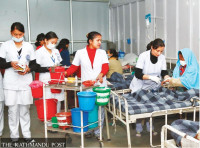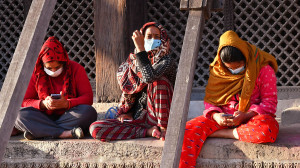Miscellaneous
Holy strays
Wednesday. 2 pm. An elderly bull, living in the stray cattle shelter near the Pashupatinath Temple, is dying.
Abijeet Pant
Wednesday. 2 pm. An elderly bull, living in the stray cattle shelter near the Pashupatinath Temple, is dying. His painful wails are drowned out by the shrill temple bells and microphoned bhajans at the busy and crowded temple premises. Gopal Neupane, who runs this shelter, is doing his best to calm the ailing animal. Then as the bhajan reaches a crescendo, the bull violently quivers and breathes its last.
Because of the constant attention the 160 cattle—that include diseased and ageing cows, and orphaned male calves—at the shelter require, stress has become part and parcel of Neupane’s daily life. The truckload of hay that he has been expecting for the last two days is still nowhere in sight. Additionally, because the dead bull now needs to be moved and buried so that any possibility of contagion is averted, Neupane sends out some of the caretakers at the facility to hire a vehicle to dispose the carcass.
Meanwhile, he uses a syringe to pierce the bull’s stomach to let the air out of an already bloating carcass. Soon after, he receives a phone-call from his caretakers that they haven’t had any luck with the vehicle. Who would want to carry a 1000 kg-heavy dead bull in their pickup?
Half a decade ago, Neupane, an avid animal lover, started this shelter to give a home to the stray cows that had become a permanent fixture of the Pashupatinath premises. He recalls knocking at doors of a dozen government offices with proposals for a land donation. Then in 2013, his proposal was finally approved and he registered the shelter as ‘Math Mandir Gai Bachha Bachau Tatha Samaj Vikas Abhiyan’.
‘‘I focused more on ‘Math and Mandirs’ in part to appeal to people’s religious sensibilities.” Neupane shares, “Initially I had hoped the centre would inspire the hundreds of thousands of devotees who visit the temple each year; but maybe I was being a little wishful.”
Housed on eight ropanies of land, this shelter is a concrete cow-shed roofed with tin, where orphaned calves and ageing cattle are housed separately. According to Neupane, the upkeep cost runs north of Rs 25000, but this can soar up to Rs 40000 if medication needs to be purchased, or, like today, a disposal vehicle needs to be hired.

“During Laxmi Puja or Govardhan Puja, hundreds of devotees come to the shelter to worship the animals,” Neupane shares, “But, as you can see, there is no footfall here during the rest of the year.” None of the cattle in the Pashupatinath area have to now face the elements, but Neupane’s shelter does not have the capacity to rescue all the stray cattle from the Valley. The Kathmandu Metropolitan City (KMC) estimates that there are around 1,200 stray cattle roaming the streets of the Capital. These animals are largely feeding on disposed garbage, drinking potentially toxic river water, and are perennially susceptible to poisoning or being overrun by vehicles. Neupane further claims that there are almost half a million stray cattle in the country, which begs the question: How do these ‘holy, animals’, especially the new born calves, end up in the streets?
Many farms operating in the outskirts of the Ring Road in the Capital abandon their male calves and non- lactating cows, says Uttam Kaphle, the executive director at Animal Nepal—an animal welfare organisation.
“Farmers are commercially driven and once an animal loses its utilitarian value, they simply become a burden on the infrastructure,” Kaphle shares, “And because there is no proper registration system that accounts for the number of bovines in Nepal, farmers can easily abandon them on roads or temple premises.”
Neupane, meanwhile, also pegs the problem on the growing mechanisation of traditional farming methods. “The advent of tractors has made ploughing very easy and efficient,” he says, “The oxen, once a mainstay of Nepali agriculture, now cannot compete with the machines and in a lot of places have become obsolete.”
According to Kaphle, an effective way to curb the number of stray cattle could lie in implementing stricter registration rules. For instance, he cites Denmark’s policies that have instituted a national database constituting of the date of birth, breed, location, veterinary history, and transportation information of every single farm animal since 1998.
“Every cow can be microchip-tagged with a unique identification code so that their owner can be easily tracked.” Kaphle says “Farmers will then be reluctant to abandon animals as there would be legal repercussions for doing so.”
“Microchipping in the case of bovines hasn’t yet been initiated in Nepal.” says Dr. Chandra Dhakal, spokesperson for the Department of Livestock Services (Ministry of Livestock Services), “But be it for monitoring any outbreaks of disease or maintaining the purity of breeds, this technology could be very useful.”
Similarly, Kaphle also emphasises the merit of encouraging breeding that uses ‘sex-sorted semen’ technology. “Using this method, an ox’s semen can be genetically modified so that it can produce only female offspring,” he shares, “Male calves—that make up a large portion of the stray cattle on Nepal’s streets—will subsequently be largely reduced.”
Furthermore, there could be other innovative solutions to the stray cattle problem. Gopal Bhandari, a researcher for the Prakritik Kheti Farm in Tokha Municipality, shares that the issue could be further addressed by publicising the potential alternative benefits of cattle. Not only can cow urine be used to prepare Ayurvedic medicine, he says, but they can also be processed into
fertilisers as well. Bhandari’s team has recently used cow dung to produce a high-quality organic fertiliser, which can be prepared within 48 hours, and lab works have proved it to be very effective.
“Cattle can be great assets, given the many benefits they can bring.” Neupane says, “And the abandonment of cattle can be curbed if this potential is tapped into.”
Moreover, Neupane’s dream project Gaulok is a nine-acre cow shelter in Kavrepalanchowk. He hopes to accommodate about 7000 stray cattle there, where the cattle can graze in a natural environment.
“But this little dream of mine will still not be enough to house all the stray bovines in Nepal.” Neupane shares, “For that, ownership at the local level is a must.”
Dr Dhakal points out that the government has already passed legal and budgetary bills that provide such authority to local governments. “All the 753 local bodies will be able to construct Kanji houses (shelters) where such strays are cared for,” he says, “If a few such strays are cared at the local level, much can be changed. It needs to.”
- Gopal Neupane tends to the stray cattle housed at his shelter.Post photo: Anish Regmi




 9.12°C Kathmandu
9.12°C Kathmandu








%20(1).jpg&w=300&height=200)

